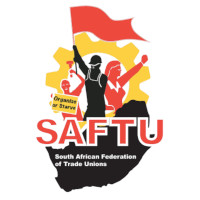The South African Federation of Trade Unions(SAFTU) is disgusted by the Monetary Policy Committee’s decision to cut policy rates by a mere pittance of 25 basis points. This quarter of a percent cut in the context of such an extremely high-interest regime will not provide any reprieve for those struggling to meet their debt obligations. Most importantly, these unjustifiably high interest rates will continue to throttle the economy.
The SARB’s reduction in the policy rate by this fraction of a percent does not translate into anything significant for those struggling to honour their debt obligations. The repo rate has been cut by 25 basis points, bringing it down to 7.75% from 8%. The prime lending rate has also been adjusted to 11.25% from 11.5%.
If a borrower receives the prime lending rate of 11.25% (and nearly all pay 1-3% higher), then a bond repayment for a house of R750 000, which was R7,998 before the cut, has now reduced to R7,798.05, which will put a mere R199,95 in that borrower’s pocket. What can one do with less than R200,00 – buy a few loaves of bread, perhaps?
When the economy reopened following the COVID-19-induced lockdown, the SARB began raising interest rates to fight inflation, which it said was caused by ‘exogenous factors’—that is, the war in Ukraine, global supply chain bottlenecks occasioned by the lockdowns, etc. Yet, despite its admission, the SARB continued to raise rates to levels unseen in recent periods.
The annual consumer price inflation fell to 2.8% in October—the lowest since the COVID-19-induced lockdowns, when it was at 2.2%. This figure puts the official consumer price inflation below the SARB’s target range of between 3.0% and 6.0%.
The mainstream commentariat has welcomed these figures with celebratory acclaim as proof of the effectiveness of the SARB’s inflation targeting. The SARB certainly pats itself on the back for a job well done.
This is the best example of a surgeon declaring that the operation has been successful, but the patient has died.
Deindustrialisation and unemployment
The daily reality of the working class continues to be unemployment, poverty and communities ravaged by crime. With unemployment at 12.2 million people, with over 30 million people living below the upper-bound poverty line, with working class children malnourished and dying like flies from poisoned food because the government has dismally failed to enforce its own laws, with 71% of the youth aimlessly roaming the streets without hope and some consumed by an epidemic of drug addiction, the working class has absolutely nothing to celebrate from the SARB’s “job well done” in bringing inflation down.
The SARB has always insisted that it is not responsible for the high levels of South Africa’s unemployment and the social ills that flow from it. Further, the SARB has always insisted that job creation is within the remit of industrial policy, not the central bank. And that its role in the economy is to “defend the value of the rand in the interest of balanced and sustainable growth”. Nothing else. The SARB claims to have excelled at this role.
However, SAFTU contends a direct link exists between the high levels of South Africa’s unemployment and how the SARB exercises monetary policy – the SARB’s claims notwithstanding. The SARB fights inflation by raising interest rates, increasing the price of credit and thereby reducing economic demand. That is, it fights inflation by inducing defaults, bankruptcies and retrenchments. Put bluntly, the SARB fights inflation by intentionally creating unemployment – by making the working class the sacrificial lamb. Therefore, its fanatical commitment to inflation targeting must be understood from a class perspective. It asks: “Which class in society ought to shoulder the burden of inflation?” And it answers resoundingly: “The working class! “The SARB’s monetary policy is based on the neoliberal dogma, which conceptualises macroeconomic policy in line with the dictates of unrestrained movement of capital – in the interest of the capitalist class. Hence, its successive relaxation of capital and exchange controls since 1995. The logic is that capital in its money and commodity form must be allowed to roam the global economy easily, exiting countries with inefficient markets and entering profitable ones. According to neoliberal wisdom, it is in this way that countries compete to have efficient markets; thereby, growth, employment, and prosperity follow. The relaxation of trade and capital controls is based on this logic.
But all that the relaxation of capital and exchange controls has done is enable illicit financial flows and place the economy at the mercy of financial speculators, forex traders and all financial swindlers. The United Nations Conference on Trade and Development (UNCTAD) estimated in 2023 that, annually, South Africa lost $62 billion or R1.1 trillion (16% of 2023 GDP) due to illicit financial flows (IFFs). These outflows include tax evasion, money laundering, profit shifting by multinational corporations, trade mis-invoicing, and corruption. The issue is part of a broader challenge across Africa, where an estimated $89 billion (around R1.6 trillion) is lost yearly-exceeding the aid received from Western countries. This money could be used to build schools and hospitals and address infrastructure backlog.
Further, the relaxation of exchange and capital control has imposed an imperative of high interest rates on the economy to entice forex traders and speculators for fear of capital flight. This has enabled international financiers to make short-term speculative trades at high rates of return at the expense of the productive economy.
This monetary policy, coupled with an industrial policy obsessed with low-wage export-led growth, has facilitated the deindustrialisation of the South African economy. Year after year, the manufacturing sector has continued to shed jobs, with the recent QLFS recording that the industry has lost 20,000 jobs.
Bankers Paradise
The result of the SARB’s rate hikes has been a massive transfer of wealth from the working and middle classes to bankers and financiers. Not only have the banking executives reaped hefty pay and bonus packages, reflecting how well banks are doing, but banks themselves have seen their profits soar to undreamt-of heights. Recent figures revealed that banking executives of South Africa’s five main banks—Standard, Nedbank, Investec, FNB, and Capitec—made a combined R456,24 million in salaries. One man alone – Standard Bank CEO Sim Tshabalala – received a total remuneration of more than R83 million in 2023.
By 2022, two years after the COVID-19-induced lockdowns, the banking sector was recording huge profits, with Capitec Bank, FNB, ABSA Group, and Standard Bank registering above 10% profit increases. This transfer of wealth to the bankers, aided and abetted by the SARB, is the source of the hefty packages accruing to top banking executives.
On the other hand, the working and middle classes are increasingly finding it difficult to meet their debt obligations. DebtBusters’s Debt Index for the fourth quarter of 2024 revealed that consumers applying for debt counselling indicated that they allocate 66% of their take-home to servicing debt – the highest debt-to-service ratio since 2017. It further revealed that South Africans earning R35 000 monthly spend 72% of their take-home pay on debt servicing costs.
Central Bank Independence: technocratic dictatorship
The SARB’s independence, which gives the Monetary Policy Committee free and unrestrained power to exercise monetary policy, is accepted by the mainstream economic pundits without question. This rule by technocracy, in which the MPC has the power to determine the economic and social fate of millions of people outside of democratic debate, is touted as the best way the economy should be run. Free and open discussion of monetary policy is disallowed, and the MPC is inoculated from politics. The depoliticisation of economic policy and its surrender to a group of unelected monetary policy committees is deeply problematic. It is class politics presenting itself as neutral and in the interest of all when, in fact, the actions of the MPC are in the interests of the financiers to the detriment of the working class.
The working class under siege
The official inflation figures notwithstanding, the working class continues to pay unjustifiably high prices for essential foods it needs to live. In its recently released Essential Food Price Monitoring Report, the Competition Commission revealed that input costs of basic food items have declined, yet their retail prices remain unjustifiably high. Put differently, the retail prices do not reflect the decline in input prices, which were said to have been responsible for the retail price increases.
This is in a country in which 47% of the population relies on social grants – of whom 18 million are on permanent grants, while 8.5 million are on Social Relief of Distress Grant of R370 even though in September 2024, twice as many – 17.2 million – applied. Three years earlier, there were only 13.8 million SRD applicants, and 4.1 million were first-time applicants. Broken down by gender, 54% were women. By educational qualification, 44% had completed matric, and 5.5% had a tertiary degree. The limitation on payment – to 8.5 million instead of 17.2 million – seems to be the artificial austerity instructions of the International Monetary Fund, which, from mid-2020 when South Africa borrowed $4.3 billion during Covid-19, has outsized power.
Fourteen of the food items the grant recipients depended on increased by R24, while the whole grant system saw an increase of a measly R10. 23. Between September 2023 and September 2024, the household food basket increased by 1.9%, from R5155.77 to R5225.68. So, while official inflation figures have come down, and the SARB is congratulating itself, the working class continues to pay unjustifiably high prices for essential foods it desperately needs to survive.
Instead, we need exchange control tightening and enforcement and a much greater interest rate cut to have the freedom to lower rates without fear of capital flight.






